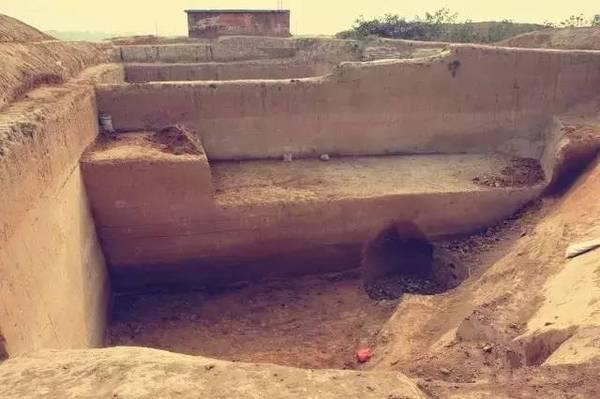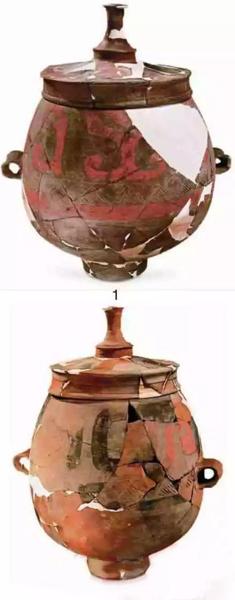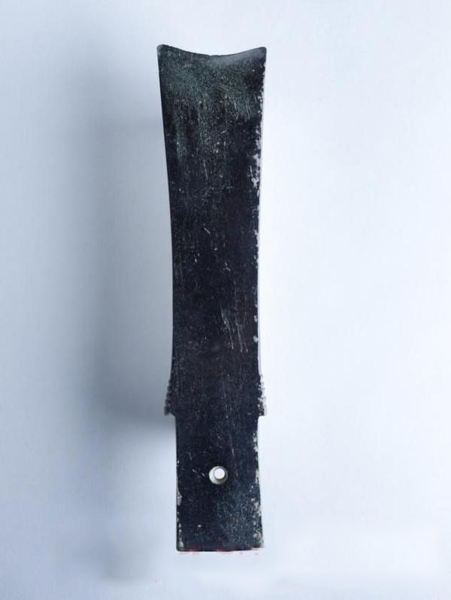In recent years, the Shuanghuaishu Site in Gongyi of Zhengzhou, Central China's Henan province, has become a hit. However, what is less known is that to its west lies the Huadizui Site, which is much closer to Luorui (洛汭) where the Luohe River flows into the Yellow River. The Huadizui Site of the early Xia Dynasty (2070 BC-1600 BC) is believed to be the place where the 5 younger brothers of Taikang, the third king of the Xia Dynasty, composed the reputational poem Songs of the Five Sons after Taikang lost power and was driven out of the city by tribal leader Yi (around 1998 BC-1940 BC).
Click on the video
On September 4, we went north from Shaochai village of Gongyi to the Huadizui Site. Can you imagine that there would be so many secrets under the seemingly ordinary field?
The Huadizui Site. [Photo provided to Henan Daily]
Archaeological site is usually named after the village in which they are located, but the Huadizui Site is an exception. Discovered in 1984, it was first called the Shuigou Site at that time, because its location belonged to Shuigou village. Now, the entry of the Shuigou Site can still be found in the book of An Atlas of Chinese Cultural Relics. However, the local villagers like to call this area Huadizui. To clearly show the exact place of the site, its original name has been replaced since 1992.
From 2001 to 2007, Zhengzhou Institute of Cultural Relics and Archaeology launched several investigations and excavations at the Huadizui Site and discovered many important cultural relics, including ring trenches, sacrificial pits, house ruins, ash pits and pottery-kiln remains. Besides, implements made of stones, bones and clamshells were also unearthed along with pottery wares, jade products, pottery wares painted with cinnabar, many animal bones and grains. The 4 ring trenches (with southeast gates) and sacrificial pits are of great significance. With rounded corners and square shape, the 3 inner trenches are quite close to each other, but have different width. The outer trench is far from the 3 inner ones with a distance of about 150 meters. With a depth of about 8 to 9 meters and a width of about 16 meters, this trench is basically trapezoidal in shape. There seems to be a northwest-southeast road linking the people within the 4 trenches with other places, since gaps have been found in the southeast part of all the trenches. These gaps should be the trenches' southeast gates. Due to severe damages, the ruins of city walls have not been discovered yet. Near the outer gate discovered multiple sacrificial pits which are irregular and nearly round in shape due to repeated usage, with a number of human bones, animal skeletons and various burial implements found.
The Huadizui Site, one of the projects aimed at tracing the origins of Chinese civilization, was listed as one of the fourth batch of provincial key cultural relicsby the People's Government of Henan Province in 2006, one of the seventh batch of national key cultural relics by the State Council in May 2013.
The two pottery wares painted with cinnabar discovered at the Huadizui Site. [Photo provided to Henan Daily]
Why is the Huadizui Site so eye-catching?
The importance of the Huadizui Site lies in its special historical background and location, according to Gu Wanfa, head of Zhengzhou Institute of Cultural Relics and Archaeology. Excavations at the Xinzhai Site in Xinmi of Zhengzhou found the cultural remains of the Xinzhai Phase (around 1870 BC-1720 BC), called the Xinzhai Culture (in other words, the early Xia Dynasty), which is between the Longshan Culture (around 2500 BC-2000 BC) and the Erlitou Culture (around 1735 BC-1530 BC). Some scholars once inferred that the stories of Taikang who lost power and Shaokang who restored Xia's governance happened during the Xinzhai Phase. So the discovery of the Huadizui Site well proved it. The remains of the Xinzhai Phase were previously found to the south of Songshan Mountain and Wan'an Mountain, while the Huadizui Site is located to the north of Songshan Mountain. Such a discovery has stimulated archaeologists to pay more attention to the northern areas of Songshan Mountain and Wan'an Mountain. Subsequently, more remains of the Xinzhai Phase were found there.
Among the large number of the cultural relics unearthed at the Huadizui Site, a teeth-shaped Zhang (a kind of blade used as ritual implement) made of black jade and two pottery wares painted with cinnabar are the most striking ones.
The teeth-shaped Zhang discovered at the Huadianzui Site. [Photo provided to Henan Daily]
The teeth-shaped Zhang discovered at the Huadianzui Site was recommended by Zhengzhou as a candidate for the selection of the greatest treasures of China's 10 ancient capitals. Unearthed in 2003, it was found tilted slightly to the southwest with two upward "teeth" and a human skeleton to the north in a burial pit intentionally filled with brown and white soil layer by layer. Previously, the oldest known teeth-shaped Zhang unearthed in Henan was believed to belong to the third stage of the Erlitou Culture (around 1635 BC-1565 BC). The later finding at the Huadizui Site can be traced back to the late Longshan Culture or the early Shimao Culture (around 4,000 years ago), which is believed to be the earliest phase when the teeth-shaped Zhang appeared. The well-preserved Zhang discovered at the Huadizui Site was produced skillfully with a unique style and is considered the oldest one in the Central Plains with a clear stratigraphic sequence.
The pottery wares painted with cinnabar unearthed were in fragments scattered in two ash pits, one in the east while the other in the west, which are close to each other. In the pits, burn marks were discovered. Restoration shows obvious oriental cultural elements on the two pottery wares, including cinnabar-painted patterns on their caps and exaggerated divinity pictures painted with the same pigment on their bodies. Some experts pointed out that these pictures are the descriptions of the Master of the Big Dipper, which indicate some relations with the events in the early Xia Dynasty.
The findings of Gu Wanfa suggest that the Huadizui Site can best represent the Xinzhai Phase remains. The less than 100-year-long history from Taikang's lose of power and Shaokang's restoration of Xia's governance is just in line with the usage duration of the Huadizui Site. According to Shih Chi, the historical record written by Sima Qian during the Western Han Dynasty (206 BC-AD 24), after Taikang lost power, his 5 younger brothers composed the poem Songs of the Five Sons in Luorui. That is to say, after the tribal leader Yi seized power, the royal families of the Xia Dynasty might be driven out and temporarily settle in Luorui area. As one of the earliest poems in China, the poem by the 5 sons of Qi (the second king of the Xia Dynasty), also the grandchildren of the Great Yu who built the Xia Dynasty, expressed their sadness. After Zhongkang (the fourth king of the Xia Dynasty) ascended the throne, the capital was moved to Zhenxun (斟鄩). Today, most scholars believe that the capital of the middle and late Xia Dynasty was located around the Erlitou Site in Yanshi of Luoyang city. (Chinese source: Henan Daily App Reporter: Zhang Tiyi Hu Chunna Translator: Zhao Hanqing Video: Wang Junyi Proofreader: Ding Lan)
Related reports
The Xia Dynasty Travel Episode II The Dongzhao Site in Zhengzhou: 'Bridgehead' of the Xia Dynasty
The Xia Dynasty Travel Episode V The Puchengdian Site: Two Ancient City Ruins Discovered
The Xia Dynasty Travel Episode VI The Xinzhai Site in Xinmi: The First Capital of the Xia Dynasty?
The Xia Dynasty Travel Episode VII The Yuzhuang Site: Unveiling the Noble Life 4,000 Years Ago
The Xia Dynasty Travel Episode IX The Erlitou Site in Yanshi: A 'Dynasty' in a Small Village





